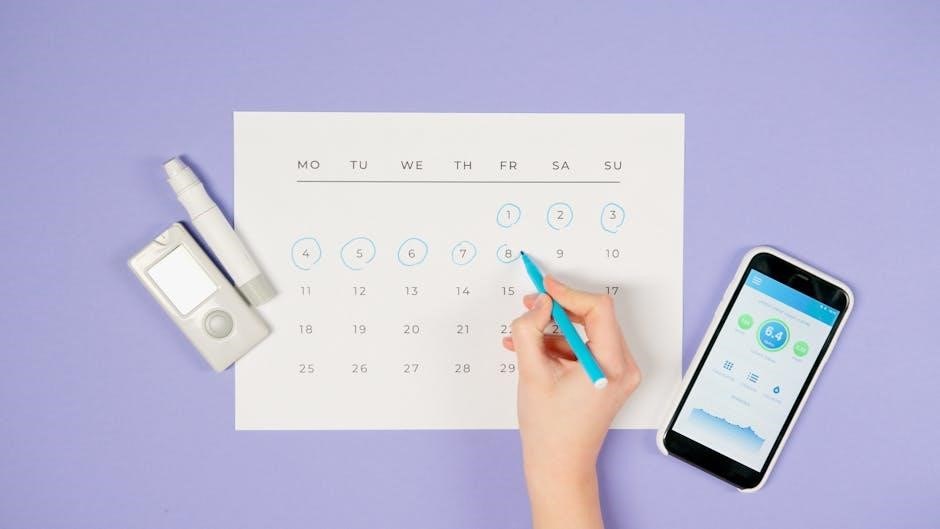The Lilly Diabetes Meal Planning Guide offers a structured approach to managing blood sugar through balanced nutrition, emphasizing carbohydrate counting, portion control, and personalized meal strategies for diabetes care.
1.1. Importance of Meal Planning in Diabetes Management
Meal planning is a cornerstone of diabetes management, helping individuals maintain blood sugar control, manage weight, and reduce the risk of complications. By structuring meals around balanced nutrition, portion control, and carbohydrate counting, individuals can stabilize glucose levels and improve overall health. A well-designed meal plan tailored to personal needs ensures adequate nutrition while preventing extreme blood sugar fluctuations. It also fosters healthier eating habits, promoting long-term glucose stability and reducing the burden on medications. For those with diabetes, consistent and informed meal planning is essential for maintaining quality of life and preventing complications. The Lilly guide provides a structured framework to achieve these goals effectively.
1.2. Overview of the Lilly Diabetes Meal Planning Guide
The Lilly Diabetes Meal Planning Guide is a comprehensive resource designed to help individuals with diabetes create personalized meal plans. It provides practical strategies for balancing nutrients, controlling portions, and managing carbohydrates to maintain stable blood sugar levels. The guide emphasizes the importance of whole foods, fiber, and protein distribution while offering flexible approaches to suit different lifestyles and dietary preferences. Additionally, it includes tools for tracking progress and adjusting meals based on blood glucose monitoring. By combining scientific insights with everyday practicality, the guide empowers users to make informed food choices, ensuring a healthy and sustainable approach to diabetes management. It is tailored to support long-term success and overall well-being.
1.3. Benefits of Using the Lilly Guide
The Lilly Diabetes Meal Planning Guide provides numerous benefits, including personalized meal strategies, improved blood sugar management, and enhanced nutritional balance. It helps users make informed food choices, promoting healthier eating habits and long-term lifestyle changes. The guide’s structured approach ensures flexibility, catering to diverse dietary needs and preferences. By focusing on balanced nutrition, it supports weight management and overall health. Additionally, the guide empowers individuals with diabetes to take control of their condition, fostering confidence in meal planning and daily decision-making. Its practical tools and insights make it an invaluable resource for achieving and maintaining optimal glucose levels and a higher quality of life.

Understanding Diabetes and Nutrition Basics
Understanding diabetes and nutrition fundamentals is crucial for effective blood sugar management. This section explores how food impacts glucose levels and provides foundational knowledge for creating balanced meal plans.
2.1. What is Diabetes?
Diabetes is a chronic health condition characterized by elevated blood sugar levels due to impaired insulin production or utilization. It affects glucose uptake, leading to high blood sugar, which can damage organs over time. The two main types are Type 1, where the pancreas doesn’t produce insulin, and Type 2, where the body resists insulin. Managing diabetes involves balancing medication, diet, and exercise to stabilize blood glucose levels and prevent complications. Proper nutrition plays a vital role in controlling symptoms and improving quality of life for individuals with diabetes.

2.2. Role of Nutrition in Managing Diabetes
Nutrition plays a cornerstone role in diabetes management, helping to regulate blood sugar levels, provide essential nutrients, and maintain overall health. A well-balanced diet focuses on controlling carbohydrate intake, as carbs directly impact blood glucose levels. Portion control, carbohydrate counting, and the glycemic index are key tools for managing diabetes through food. Protein, healthy fats, and fiber are also crucial, as they help stabilize blood sugar and provide satiety. Proper nutrition not only prevents spikes in blood sugar but also supports heart health and weight management, reducing the risk of diabetes-related complications. By understanding and applying dietary principles, individuals with diabetes can achieve better control and improve their quality of life.
2.3. Key Nutritional Concepts for Diabetes
Key nutritional concepts for diabetes management focus on balancing macronutrients, controlling portion sizes, and understanding how foods affect blood sugar. Carbohydrates, proteins, and fats are essential, but their proportions vary based on individual needs. Carbohydrates, especially, impact blood glucose levels the most, so tracking them is crucial. The glycemic index helps identify which carbs cause slower or faster spikes in blood sugar; Incorporating fiber-rich foods, such as whole grains, fruits, and vegetables, aids in stabilizing blood sugar and improving digestion. Healthy fats, like those from nuts and avocados, support heart health. Proper hydration and mindful eating are also vital for overall well-being. These concepts guide personalized meal plans to maintain stable blood glucose levels and promote long-term health.

Core Components of the Lilly Diabetes Meal Plan
The Lilly Diabetes Meal Plan focuses on balanced nutrition, emphasizing portion control, carbohydrate counting, and the glycemic index. It also highlights protein, fat distribution, and incorporating fiber-rich whole foods.
3.1. Balanced Diet and Portion Control
A balanced diet is central to the Lilly Diabetes Meal Plan, emphasizing variety and nutrient-dense foods. It focuses on distributing calories across meals to maintain stable blood sugar levels. Portion control is highlighted as a critical tool for managing carbohydrate intake and overall calorie consumption. The guide encourages using measuring cups or a food scale to accurately assess portion sizes. Additionally, visual aids like the Diabetes Plate Method are recommended to help individuals estimate appropriate food proportions. By combining balanced nutrition with mindful portion control, the plan aims to simplify meal planning and support long-term diabetes management effectively.
3.2. Carbohydrate Counting and Glycemic Index
Carbohydrate counting is a key strategy in the Lilly Diabetes Meal Plan, focusing on managing blood sugar by tracking carb intake. The guide emphasizes understanding how different carbs impact glucose levels, using the glycemic index to identify low, medium, and high-impact foods. By prioritizing whole, unprocessed foods with a lower glycemic index, individuals can achieve more stable blood sugar levels. The plan provides practical tools for measuring carb portions and offers tips for balancing meals. This approach helps prevent blood sugar spikes and supports overall diabetes management, promoting better health and energy balance.
3.3. Protein and Fat Distribution in Meals
Protein and fat distribution play a crucial role in balancing meals within the Lilly Diabetes Meal Plan. Protein helps regulate blood sugar and provides satiety, while healthy fats support heart health. The guide recommends incorporating lean proteins like poultry, fish, and legumes, along with healthy fats such as avocados and nuts. Balancing these nutrients helps maintain energy levels and prevents excessive carbohydrate intake. Portion control is emphasized to ensure meals are nutritionally balanced. By pairing protein with complex carbs and healthy fats, individuals can achieve stable blood sugar levels. This approach supports overall metabolic health and makes meals more satisfying and flexible for diabetes management.
3.4. Incorporating Fiber and Whole Foods
Incorporating fiber and whole foods is essential for blood sugar management and overall health. High-fiber foods like vegetables, whole grains, and legumes slow carbohydrate absorption, preventing rapid blood sugar spikes. The Lilly Diabetes Meal Plan emphasizes whole, unprocessed foods over refined or sugary options. Fiber-rich foods also promote digestive health and satiety, reducing overall carbohydrate intake. Whole foods provide essential vitamins, minerals, and antioxidants that support immune function and energy levels. By prioritizing whole grains, lean proteins, and a variety of colorful vegetables, individuals can create balanced meals that align with diabetes management goals. This approach fosters a sustainable and enjoyable eating pattern for long-term health benefits.

Creating a Daily Meal Plan
Creating a daily meal plan involves balanced nutrition, portion control, and tailored strategies to meet individual caloric and nutritional needs for effective diabetes management;
4.1. Assessing Caloric and Nutritional Needs
Assessing caloric and nutritional needs is crucial for creating an effective meal plan. Factors such as age, weight, activity level, and dietary preferences are considered to determine daily requirements. A healthcare provider or dietitian can help calculate the appropriate caloric intake and balance of macronutrients like carbohydrates, proteins, and fats. Monitoring blood sugar levels and adjusting the plan based on glucose trends ensures optimal management. This step also involves identifying any food allergies or preferences to tailor the plan individually. By understanding nutritional needs, individuals can make informed choices that support blood sugar control and overall health. This personalized approach fosters long-term success in diabetes management.
4.2. Planning Breakfast, Lunch, Dinner, and Snacks
Planning balanced meals and snacks is essential for maintaining steady blood sugar levels. Breakfast should include a mix of protein, healthy fats, and complex carbs to start the day right. Lunch and dinner should feature lean proteins, whole grains, and colorful vegetables, while snacks can include nuts, fruits, or yogurt to prevent blood sugar dips. Portion control and carbohydrate counting are key to avoid overeating and manage glucose spikes. Incorporating fiber-rich foods helps slow digestion and stabilize blood sugar. Each meal and snack should be spaced evenly throughout the day to maintain energy levels and metabolic balance. This structured approach ensures nutritional needs are met while keeping blood sugar in check.
4.3. Sample Meal Plans for Different Caloric Requirements
The Lilly Diabetes Meal Planning Guide provides adaptable sample meal plans tailored to various caloric needs, ensuring balanced nutrition for effective blood sugar management. For example, a 1,200-calorie plan might include oatmeal with nuts for breakfast, grilled chicken salad for lunch, and baked fish with vegetables for dinner. A 1,800-calorie plan could feature scrambled eggs with whole-grain toast, turkey wraps, and quinoa-stuffed chicken. Snacks like Greek yogurt or almonds are suggested to maintain energy levels. These plans emphasize protein, whole grains, and vegetables, with portion sizes adjusted to meet individual caloric goals. They also offer flexibility, allowing for substitutions based on personal preferences or dietary needs, ensuring a sustainable and enjoyable approach to meal planning.
4.4. Adjusting the Plan Based on Blood Sugar Levels
Monitoring blood sugar levels is crucial for refining the Lilly Diabetes Meal Plan. By tracking glucose trends, individuals can identify how specific foods and portions affect their blood sugar. For example, if post-meal glucose levels are consistently high, reducing carbohydrate intake or choosing lower glycemic index foods may be necessary. Adjustments can also involve modifying portion sizes or balancing meals with more protein and fiber to slow sugar absorption. Regularly reviewing blood sugar logs with a healthcare provider helps tailor the plan to individual needs, ensuring optimal blood sugar control and overall health. This iterative process makes the meal plan flexible and responsive to personal metabolic changes.

Advanced Meal Planning Strategies
Advanced strategies involve managing carbohydrates, pairing foods to optimize glucose levels, incorporating physical activity, and handling special diets or preferences to enhance blood sugar control and flexibility.
5.1. Managing Carbohydrates for Better Blood Sugar Control
Carbohydrates impact blood sugar the most, so tracking them is crucial. The Lilly guide suggests balancing carbs with protein and fats, choosing complex carbs like whole grains, and avoiding refined sugars. Portion control and pairing carbs with fiber can slow digestion, preventing spikes. Tools like food lists and glycemic index charts help identify better choices. Regular monitoring and adjusting carb intake based on blood sugar levels ensures optimal control. This strategy helps maintain stable glucose levels and supports overall diabetes management effectively. Consistency is key to achieving long-term success with this approach.
5.2. Pairing Foods to Optimize Glucose Levels
Pairing foods strategically helps stabilize blood sugar levels. Combining carbohydrates with protein, healthy fats, and fiber slows digestion, reducing blood sugar spikes. For example, pairing whole grains with lean meats or adding vegetables to meals balances glucose absorption. Incorporating foods with a low glycemic index, such as legumes or nuts, further optimizes glucose control. Avoiding refined sugars and high-glycemic foods minimizes fluctuations. Regularly monitoring blood sugar responses to food combinations allows for tailored adjustments. This approach enhances meal satisfaction and supports long-term glucose management, aligning with the Lilly guide’s emphasis on personalized nutrition for diabetes care.
5.3. Incorporating Physical Activity into Meal Planning
Physical activity plays a key role in glucose management, and aligning it with meal planning enhances its benefits. Regular exercise improves insulin sensitivity, helping cells absorb glucose more efficiently. The Lilly guide suggests adjusting meal timing and portion sizes based on activity levels to maintain stable blood sugar levels. For example, consuming a balanced meal with carbohydrates and protein before exercise can provide energy and prevent hypoglycemia. Afterward, a snack or meal containing protein and complex carbs aids recovery and replenishes glycogen stores. Monitoring blood sugar before and after exercise ensures safety and informs meal adjustments, creating a holistic approach to diabetes management that combines nutrition and physical activity for optimal results.
5.4. Handling Special Diets and Preferences
The Lilly Diabetes Meal Planning Guide accommodates diverse dietary needs, ensuring tailored meal plans for individuals with specific preferences or restrictions. Whether vegetarian, vegan, low-carb, or other special diets, the guide provides flexible strategies to incorporate preferred foods while maintaining blood sugar control. It emphasizes using food lists and exchange systems to make informed choices. For example, plant-based protein sources can replace meats, and low-carb alternatives can be substituted for traditional grains. Additionally, the guide encourages consulting with a registered dietitian or diabetes educator to address unique needs effectively. This personalized approach ensures that cultural, lifestyle, and dietary preferences are seamlessly integrated into the meal planning process for optimal diabetes management and satisfaction.

Tracking and Monitoring Progress
Regularly tracking meals and blood sugar levels helps identify patterns and areas for improvement. Using a food diary and monitoring glucose levels ensures accountability and informed adjustments to the meal plan;
6.1. Using a Food Diary for Accountability
A food diary is a powerful tool for tracking daily eating habits, portions, and blood sugar levels. By documenting meals, snacks, and beverages consumed, individuals gain clarity on their dietary choices. This tool helps identify patterns, such as overeating or carbohydrate-heavy meals, and highlights areas for improvement. Recording blood sugar readings before and after meals adds another layer of insight, revealing how specific foods affect glucose levels. Over time, this data empowers users to make informed adjustments to their meal plans, fostering better glucose control. Additionally, a food diary can help manage cravings and portion sizes. Regular use of a food diary promotes accountability and long-term success in diabetes management.
6.2. Monitoring Blood Sugar Levels
Monitoring blood sugar levels is essential for understanding how food, activity, and medications affect glucose control. Regular blood sugar checks help identify patterns and prevent complications. Using tools like glucometers or continuous glucose monitors (CGMs), individuals can track their levels throughout the day. This data is crucial for adjusting meals, portion sizes, and carbohydrate intake. Blood sugar levels should be checked before meals, after eating, and at bedtime to gauge the impact of dietary choices. Maintaining a log of these readings alongside food intake and physical activity provides valuable insights for refining the meal plan. Consistent monitoring ensures better glucose management and long-term health outcomes for individuals with diabetes. Regular tracking also helps in making informed decisions to stay within target ranges. By combining blood sugar data with meal planning, users can optimize their diabetes care and achieve stable glucose levels.
6.3. Adjusting the Meal Plan Based on Progress
Regularly reviewing and adjusting your meal plan is crucial for effective diabetes management. By monitoring blood sugar levels, food intake, and physical activity, you can identify patterns and areas for improvement. If blood sugar levels are consistently high, consider reducing carbohydrate portions or increasing protein and fiber intake. Conversely, if levels are too low, small adjustments to carbohydrate servings may be necessary. Tracking progress in a food diary helps pinpoint specific foods or meals that impact glucose levels. Adjustments should be gradual, allowing time to observe changes; Consulting with a healthcare provider or dietitian ensures safe and effective modifications. Tailoring the meal plan based on progress promotes better glucose control and long-term health outcomes. Continuous adaptation is key to maintaining a balanced and effective diabetes management strategy.

Common Challenges and Solutions
Managing diabetes through meal planning involves overcoming challenges such as food cravings, dining out, and special occasions, which can be addressed with strategic planning and support systems.
7.1. Dealing with Food Cravings
Food cravings can be a significant challenge for individuals managing diabetes. To address this, the Lilly Diabetes Meal Planning Guide suggests identifying triggers and planning healthier alternatives. Incorporating fiber-rich foods and protein into meals can help stabilize blood sugar and reduce cravings. Mindful eating practices, such as portion control and gradual indulgence, can also curb impulsive choices. Additionally, staying hydrated and choosing nutrient-dense snacks like fruits, nuts, or vegetables can satisfy cravings without compromising glucose control. By integrating these strategies into a structured meal plan, individuals can better navigate cravings while maintaining their diabetes management goals. Consistency and support systems are key to long-term success.
7.2. Eating Out and Staying on Track
Eating out while managing diabetes requires careful planning to stay on track. The Lilly Diabetes Meal Planning Guide recommends reviewing menus beforehand, choosing restaurants with healthy options, and opting for smaller portions. Avoid sugary drinks and focus on dishes that are grilled, baked, or steamed. Pair protein with vegetables to balance your meal and control carbohydrate intake. If dessert is tempting, consider sharing or selecting a small, low-carb option. Mindful eating and portion awareness are key to maintaining blood sugar control. By using the guide’s strategies, individuals can enjoy dining out while adhering to their diabetes management plan, ensuring a balance between pleasure and health.
7.3. Managing Holidays and Special Occasions
Holidays and special occasions often present challenges for diabetes management due to tempting treats and large meals. The Lilly Diabetes Meal Planning Guide suggests planning ahead by reviewing the menu, selecting smaller portions, and prioritizing protein and vegetables. Opt for healthier dessert options like fruit or dark chocolate in moderation. Staying hydrated and avoiding overindulgence can help maintain blood sugar balance. Consider bringing a diabetes-friendly dish to share, ensuring there are options that align with your meal plan. By setting boundaries and practicing mindful eating, individuals can enjoy celebrations while staying on track with their diabetes management goals. Tracking intake in a food diary can also provide accountability and help adjust future plans.

Additional Resources and Tools
The Lilly Diabetes Meal Planning Guide offers access to mobile apps, websites, and educational books for better diabetes management. Joining support communities also provides valuable shared experiences and tips.
8.1. Recommended Books and Websites

For further learning, the Lilly Diabetes Meal Planning Guide recommends books like The Diabetes Plate and Eat Out, Eat Well. These resources provide practical tips for balanced diets. Websites such as ADA.org and Diabetes.org offer comprehensive guides on meal planning and tracking blood sugar. Mobile apps like MyFitnessPal and Lose It! can help track daily food intake and nutritional balance. Additionally, online platforms such as Academy of Nutrition and Dietetics provide reliable information on healthy eating. These tools complement the Lilly guide, offering diverse strategies to manage diabetes effectively through informed food choices and personalized plans.
8.2. Mobile Apps for Diabetes Management
Several mobile apps complement the Lilly Diabetes Meal Planning Guide, offering tools for tracking and managing diabetes; Apps like MyNetDiary and Carb Counter help users monitor carbohydrate intake and track blood sugar levels. Mealime and Yummly provide healthy recipe ideas tailored to dietary needs. GlucoGuide and Diabetes Tracker allow users to log meals, exercise, and medication, offering insights for better blood sugar control. These apps support the principles outlined in the Lilly guide by encouraging consistent tracking and informed food choices. They act as digital companions, helping users stay organized and motivated in their diabetes management journey.
8.3. Joining Diabetes Support Communities
Joining diabetes support communities provides invaluable emotional and practical support for managing the condition. These communities, whether online forums or local groups, connect individuals with shared experiences, fostering camaraderie and understanding. Members often share tips, recipes, and strategies for adhering to meal plans like the Lilly Diabetes Guide. Such networks also offer encouragement, helping participants stay motivated and resilient. Many communities host educational events or webinars, featuring experts who provide insights on nutrition and lifestyle changes. By engaging with others facing similar challenges, individuals gain a sense of belonging and empowerment, which is crucial for long-term diabetes management and overall well-being.
The Lilly Diabetes Meal Planning Guide provides a comprehensive, structured approach to managing diabetes through balanced nutrition, empowering individuals to achieve long-term health and wellness effectively and confidently.
9.1. Summarizing the Key Points
The Lilly Diabetes Meal Planning Guide emphasizes balanced nutrition, portion control, and tailored meal strategies to manage blood sugar effectively. It highlights the importance of carbohydrate counting, glycemic index awareness, and incorporating fiber-rich foods. The guide also stresses the role of protein and fats in meal distribution and provides practical tips for creating daily meal plans. By focusing on individual caloric needs and adjusting based on blood sugar levels, the guide empowers individuals to maintain healthier eating habits. It encourages tracking progress through food diaries and regular blood sugar monitoring, offering solutions to common challenges like cravings and dining out. Ultimately, the guide serves as a comprehensive tool for long-term diabetes management and overall well-being.
9.2. Encouragement for Long-Term Success
Adhering to the Lilly Diabetes Meal Planning Guide requires commitment, but the long-term benefits are profound. Consistency in meal planning and blood sugar monitoring can lead to improved health outcomes and increased energy levels. Celebrate small victories, like making healthier food choices or maintaining balanced blood sugar levels, to stay motivated. Remember, diabetes management is a journey, and every positive step contributes to overall well-being. Seek support from healthcare providers, family, and diabetes communities to stay encouraged. With time and practice, the guide’s strategies will become second nature, empowering you to take control of your health and thrive.
